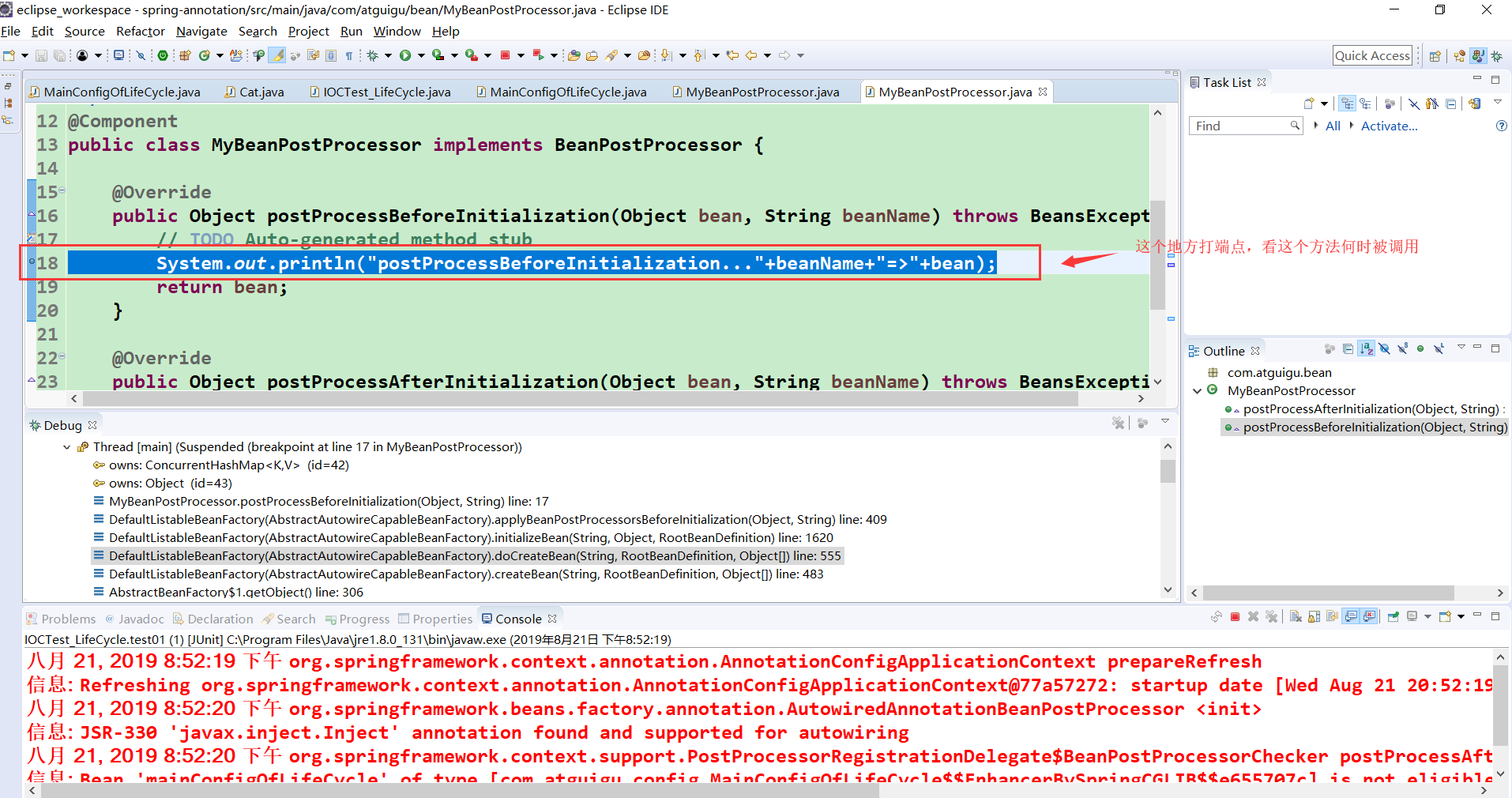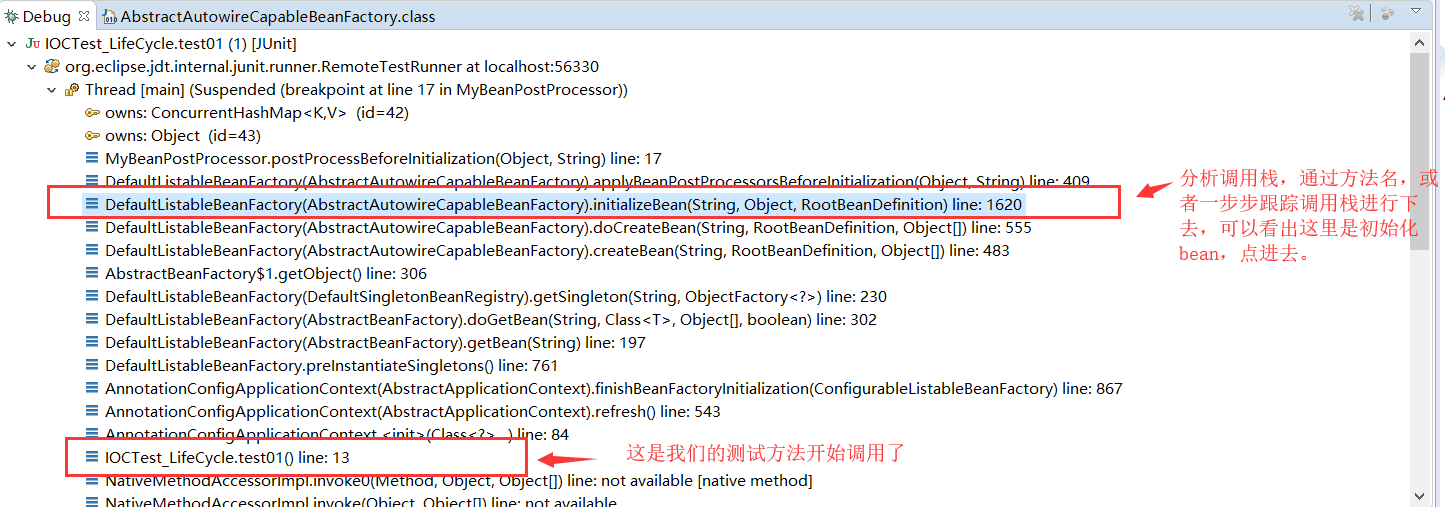BeanPostProcessor我们一般称为Bean的后置处理器,它与我们前面介绍的InitialingBean、init-method等一样,都是在bean的初始化时被调用,具体的用法我们在举例中进行学习。
要使用BeanPostProcessor非常简单,只要实现这个接口即可。
在此之前,我们来先看下我们的Cat类,我们的目的是将这个Cat注册进spring的ioc容器中,并让这个BeanPostProcessor起到作用。
public class Cat implements InitializingBean,DisposableBean {
public Cat(){
System.out.println("cat constructor...");
}
@Override
public void destroy() throws Exception {
// TODO Auto-generated method stub
System.out.println("cat...destroy...");
}
@Override
public void afterPropertiesSet() throws Exception {
// TODO Auto-generated method stub
System.out.println("cat...afterPropertiesSet...");
}
//对象创建并赋值之后调用
@PostConstruct
public void initMethod(){
System.out.println("Cat....@PostConstruct...");
}
//容器移除对象之前
@PreDestroy
public void detoryMethod(){
System.out.println("Cat....@PreDestroy...");
}
public void initCat() {
System.out.println("Cat.initCat()......");
}
public void cleanup() {
System.out.println("Cat.cleanup()......");
}
}
再来看下我们的配置类
@Configuration
public class MainConfigOfLifeCycle {
// @Scope("prototype")
@Bean(initMethod="initCat",destroyMethod="cleanup")
public Cat cat(){
return new Cat();
}
@Bean
public MyBeanPostProcessor myBeanPostProcessor() {
return new MyBeanPostProcessor();
}
}
结合之前学习过的内容, 就能知道我们为这个Cat类应用了三种初始化及销毁方法,
分别是@PostConstruct和@Predestroy
还有就是实现 InitializingBean,DisposableBean这两个接口的afterPropertiesSet()和destro()方法
另外就是标注在@Bean(initMethod="initCat",destroyMethod="cleanup")定义的两个方法,也存在于Cat类中,
现在我们就要加入BeanPostProcessor
/**
* 后置处理器:初始化前后进行处理工作
* 将后置处理器加入到容器中,只需要继承BeanPostProcessor接口并实现其两个方法即可。
*/
@Component
public class MyBeanPostProcessor implements BeanPostProcessor {
@Override
public Object postProcessBeforeInitialization(Object bean, String beanName) throws BeansException {
System.out.println("postProcessBeforeInitialization..."+beanName+"=>"+bean);
return bean;
}
@Override
public Object postProcessAfterInitialization(Object bean, String beanName) throws BeansException {
System.out.println("postProcessAfterInitialization..."+beanName+"=>"+bean);
return bean;
}
}
现在一切具备,再写一个测试方法:
@Test
public void test01(){
//1、创建ioc容器
AnnotationConfigApplicationContext applicationContext = new AnnotationConfigApplicationContext(MainConfigOfLifeCycle.class);
System.out.println("容器创建完成...");
//applicationContext.getBean("car");
//关闭容器
applicationContext.close();
}
观察控制台打印结果
cat constructor...// 创建cat对象
postProcessBeforeInitialization...cat=>com.atguigu.bean.Cat@6591f517 //在所有初始化方法之前被调用
Cat....@PostConstruct...
cat...afterPropertiesSet...
Cat.initCat()......
postProcessAfterInitialization...cat=>com.atguigu.bean.Cat@6591f517// 在所有初始化方法之后被调用
容器创建完成...
Cat....@PreDestroy...// 销毁方法不需要关注
cat...destroy...
Cat.cleanup()......
通过上面这个例子,已经很显然BeanPostProcessor的用法,它是在容器中bean初始化前后被调用。
源码调用分析:

我们在eclipse中启用debug模式,

看看这个方法的源码,直接在方法注释中进行分析
protected Object initializeBean(final String beanName, final Object bean, RootBeanDefinition mbd) {
if (System.getSecurityManager() != null) {
AccessController.doPrivileged(new PrivilegedAction<Object>() {
@Override
public Object run() {
invokeAwareMethods(beanName, bean);
return null;
}
}, getAccessControlContext());
}
else {
invokeAwareMethods(beanName, bean);
}
Object wrappedBean = bean;
if (mbd == null || !mbd.isSynthetic()) {
// 初始化前调用BeanPostProcessor
wrappedBean = applyBeanPostProcessorsBeforeInitialization(wrappedBean, beanName);
}
try {
//初始化方法
invokeInitMethods(beanName, wrappedBean, mbd);
}
catch (Throwable ex) {
throw new BeanCreationException(
(mbd != null ? mbd.getResourceDescription() : null),
beanName, "Invocation of init method failed", ex);
}
if (mbd == null || !mbd.isSynthetic()) {
// 初始化后调用BeanPostProcessor
wrappedBean = applyBeanPostProcessorsAfterInitialization(wrappedBean, beanName);
}
return wrappedBean;
}
就看到这里,里面内容比较多,可以进invokeInitMethods看看几个初始化方法的调用顺序,JSR-250注解@PostConstruct是如何起作用的等等 ,我们这里只是来源码中找找它在源码中的位置。
又是一个夜晚,一船的清梦。